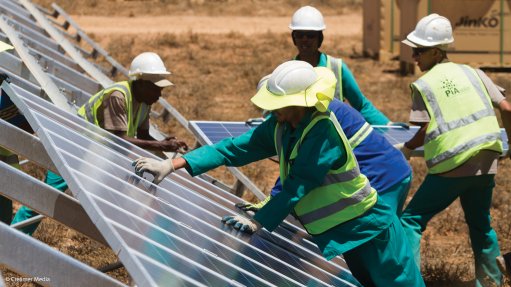
Photo by: Creamer Media
South Africa’s emerging solar photovoltaic (PV) value chain has significant potential to create employment over the current decade as utility scale and small-scale embedded generation (SSEG) capacity is added in response to the country’s Integrated Resource Plan of 2019 (IRP 2019) and moves by businesses and households to bolster security of supply through rooftop investments.
A new ‘Solar PV Industry Jobs Report’ states that between 11 000 and 13 000 permanent operations and maintenance (O&M) jobs could be created by 2030, along with up to 40 000 full-time equivalent (FTE) jobs every year in the preparation, development and construction of domestic solar projects.
The report defines FTE jobs as equal to one person working full time over the course of a year and provides estimates of the historical and future job creation potential of the domestic industry based on FTE jobs created for every solar PV megawatt added over a period of a year.
Commissioned by the South African Photovoltaic Industry Association and produced by the Council for Scientific and Industrial Research (CSIR), the report was compiled following an extensive literature review as well as from data collected from companies active in the domestic solar industry.
As anticipated, the report confirms that the bulk of the initial jobs will be created in project construction, with O&M employment growing cumulatively as the installed base increases.
There is also potential to create permanent jobs in the manufacturing of solar PV components, but as with construction jobs, these will depend on the consistency of procurement, which is set to resume this year following a seven-year pause.
Releasing the report’s findings on Wednesday, CSIR Energy Centre head Dr Clinton Carter-Brown said that the research indicated that the solar PV value chain in South Africa had already expanded materially over the past decade, with nearly 1 000 companies directly linked to the industry.
These firms included independent power producers and project developers, legal and technical service providers, manufacturers and engineering, procurement and construction contractors.
Carter-Brown said the market was expected to grow substantially over the current decade, but that the scale of that expansion, and the associated employment opportunities, would depend largely on policy decisions and procurement consistency.
The report modelled four scenarios, including one based on the IRP 2019, which envisages the building of more that 6 000 MW of new utility solar PV capacity between 2020 and 2030, but also includes procurement gaps in 2024, 2026 and 2027 during which only SSEG projects are catered for.
Although SSEG projects are more job intensive, at 39 FTE jobs for every megawatt added, when compared with 17 for utility scale projects, CSIR energy economist Ruan Fourie highlighted that the procurement gaps would disrupt the yearly employment opportunities that could be expected over the period.
The number of FTE jobs was expected to surge to over 38 700 next year in light of procurement processes being implemented in line with the IRP 2019, but would drop to below 15 000 in 2024, and below 15 900 in 2026 and 2027 in line with the procurement gaps, before recovering to above 33 000 a year from 2028 onwards.
Under scenarios that eliminated those procurement gaps, the decline from 2022 would be far less steep and the yearly FTE jobs profile to 2030 significantly smoother.
Under the report’s ‘high road scenario’ the solar PV industry could be expected to consistently create between 38 000 and 40 000 FTE jobs yearly between 2028 and 2030 and support between 11 000 and 13 000 O&M jobs.
Fourie said that its analysis of the jobs data between 2011 and 2018 highlighted the negative impact that South Africa’s procurement disruptions – which resulted in projects procured in 2014 only reaching financial close in 2018 and the first new procurement initiated only this year – had had on employment opportunities in the sector.
The losses were particularly pronounced in the construction sector, but were also felt across other parts of the supply chain, including manufacturing.
“Periods of no or low new utility scale solar PV capacity additions will negatively impact on the sustainability of jobs in the sector,” Fourie stressed, adding that building local industrial capacity to supply the solar industry would also depend heavily on buildout consistency.
To accelerate job-intensive SSEG deployments, meanwhile, policy certainty and enabling regulatory frameworks would be required. Carter-Brown said that a recent move to raise the licence-exemption cap from 1 MW to 10 MW could help stimulate growth in the sector.
He said that the good news from the report was that it reaffirmed the CSIR’s previous assessment that the renewables industry as a whole would generate more net jobs than those that currently existed in the coal value chain, which is expected to shed about 40 000 jobs by 2030 as Eskom's coal-fired power stations are decommissioned.
The challenge, he said, lay in addressing the spatial and local contexts, in light of the fact that much of the decline impacts in the coal sector would be concentrated in specific regions, such a Mpumalanga, while solar would be deployed across the country.
Fourie argued that while the report pointed to solar PV playing some role in facilitating a ‘just transition’, the solution probably required a broader multi-sector approach to ensure that coal workers, communities and firms were adequately supported.